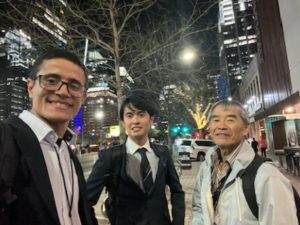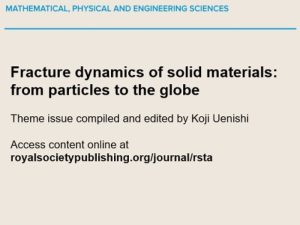
Hello! I’m Tanabe, a major teacher. It’s May. Is it a place where you are relieved to welcome the consecutive holidays as you are gradually released from the hassle of starting the new year? I think that the new students are preparing to start research little by little after the course is decided, and the senior students are renewing their feelings by seeing the situation of such new students and realizing that the grade has risen.
By the way, this is my major blog, but since I started this year as a new student at Tanabe Lab, I would like to take this opportunity to reiterate my new appointment and introduce my research field. Since I was active as an assistant professor in the Ono / I laboratory at this time of last year, I had the opportunity to talk to M2 and above in major journals and practical training courses, but from this year onwards With the addition of specialized subjects, I think there will be more opportunities to interact with everyone. Since I am also an alumnus of the major, I will actively support if I notice any inconvenience from the student’s point of view, remembering when I was a major student. Thank you.
Tanabe Lab deals with nuclear fusion and space plasma experiments as a research field. Our graduate school has a large number of plasma laboratories, but in this field, we are focusing on the three fields of “spherical tokamak”, “magnetic reconnection”, and “advanced plasma diagnosis”. I am conducting research activities.
In recent years, in fusion energy development research, it is only a few years before the first plasma generation of the international thermonuclear experimental reactor ITER is completed, and in the experiment of the Column Research Institute JET near Oxford, UK, the heavy hydrogen-triple hydrogen (DT) fusion reaction is actually carried out. In the future, ITER will conduct a combustion experiment with an increased Q value, which is expressed by the ratio of Q = heat output / input energy, such as the demonstration and semi-steady maintenance experiment that will occur in ITER, and the heat output of 59 MJ will be recorded and announced in the press in 2022. It is planned. What should universities do in this modern age of ITER? The spherical tokamak field is one of the research fields that is being promoted as the next step after post-ITER. When we think of magnetically confined fusion plasma, we generally think of a donut-shaped plasma, but in the spherical tokamak method, the large radius of the entire plasma ring is small, and the small radius of the donut cross section is large, making it a shape close to a spherical shape as a whole. It is said that it is a big attraction that β = plasma thermal pressure / magnetic pressure ratio (beta value) can be taken very large with respect to tokamak because of the magnetic field coordination. Compared to a nuclear fission reactor, the cost of a coil system that creates a confinement magnetic field is added to a fusion reactor, so if a power generation reactor is constructed based on the similarity measurement as it is from the ITER method, it will cost nearly two to three times as much as the nuclear power plant. It is supposed to be closed. Even with clean energy, will the electric power company choose a fusion reactor if two or three nuclear power plants can be constructed with the same budget? Not only for super-large projects with a construction period of 10 years or more that exceeds the scale of ITER. If we can create a compact core scenario that makes it easy for electric power companies to draw an investment / return composition like other power generation methods, it should be a big attraction, and we are conducting research activities with this as a motivation.
In this laboratory, in collaboration with Ono (Yasushi) Lab., I Lab., And Usami Lab., We borrowed an idea from space plasma as an efficient generation method of this spherical tokamak plasma, and the basic physics of explosive energy release phenomenon such as solar flare. Focusing on the core scenario, which is known as “magnetic reconnection”, which actively drives the particle acceleration / heating phenomenon that accompanies the connection of magnetic lines by plasma coalescence, and performs rapid heating at the same time as plasma startup. I am doing research. The coalescence method developed at the University of Tokyo is currently being adopted by overseas fusion ventures, and the “Young Researcher International Expansion Project” dispatched to the UK Tokamak, which was previously introduced in the blog on September 14, 2019. Energy is conducting vigorous application experiments. Compared to the tokamak-helical method, which is the mainstream of fusion research so far, the spherical tokamak method has a young history, and its weakness was that “there is no device that has reached the 100 million degree range yet”. In the ST40 experiment, after the first plasma was generated in 2018, several million to 20 million degrees were recorded by plasma fusion, then additional heat was added by a neutral particle beam, and in 2022, after verification by a charge exchange spectroscope, finally 1 The press release exceeded 100 million degrees, and it was big news that the spherical tokamak experiment entered the 100 million degree area, which is one of the milestones of the fusion industry.
How is spontaneous heating by coalescence / reconnection, in which the temperature rises instantly on the microsecond time scale, compared to the external heat input on the 100 millisecond time scale by the neutral particle beam, which is familiar to tokamak and helical. I wonder if this should be understood, this is also a subject of great interest in space plasma such as solar flare, and JAXA’s Hinode as “laboratory astronomy” that the spherical tokamak coalescence generation experiment can reproduce the phenomenon of space plasma on the ground. We may also participate in physical research in collaboration with the satellite research group. Unlike observations that rely on spontaneous events of space plasma, it is possible to actively induce phenomena of interest in the laboratory, so if phenomena similar to space plasma can be reproduced on the ground, parameters that cannot be measured in space It is possible to systematically study changes caused by direct measurement and active changes of specific parameters, and active interdisciplinary science research to discover new findings through collaboration of theory, simulation, satellite observation, and experiments. It is done in. In the case of satellite observation, remote measurement is often used in an environment where multi-point in-situ measurement is difficult, such as solar plasma, and the structure of the optical measurement field in the depth direction cannot often be decomposed. By applying CT technology, it is possible to perform tomographic imaging and parameter distribution measurement on tomography by measuring the field of view from multiple directions. That discovery often leads to the world’s most advanced physics elucidation. Plasma physics is a very large discipline, so it takes time to master it, but even before the knowledge is sufficient, when specializing in a specific field of plasma diagnosis, the expertise of students may exceed that of faculty members. Often, you can gain confidence in the early stages of your research career through experience such as presentations at academic conferences. Unlike the physical consideration of the model, the data tells us everything when a powerful measuring instrument that can diagnose the internal state of the plasma in detail is established, so the world’s first new discovery that betrays the conventional prediction is pioneered. Often.
Generally, in a fusion-based laboratory, the first anxiety that students and freshmen have is how to create their own uniqueness in a situation where everyone uses common experimental equipment. As shown in the image, we have adopted a method of designing each sector of the vacuum vessel so that it can be replaced from the beginning. The child flanges of each sector can be divided, including the modification of a large structure as shown in the image of removing each sector in the cross-sectional view in the axial direction of the device. Since the composition of each sector in charge is relatively free to work on for each project, the degree of freedom that makes use of the mobility of the university compared to large equipment. An environment is in place for high-level research. Recently, in addition to this, work is underway to change the configuration of the components that will be installed inside the vacuum vessel by removing the lid in the axial direction of the device. It is held immediately after the start of the new semester, when the busy season has settled down by sending out graduates.
As mentioned above, although it has become very long, I would like to give a greeting from my new appointment and an overview of my research field and an introduction to the latest situation. Development of advanced plasma diagnosis to discover undiscovered new phenomena, the aspect of our graduate school’s nuclear fusion research and education program, the style of laboratory astronomy that systematically studies the physics of space plasma on the ground. At Tanabe Lab, we are conducting research activities with these three pillars as pillars. Since it is a young laboratory just after its establishment, there may be various things that may not be reached, but while remembering the time when I was a fledgling first year master’s student, in addition to research, I will also be involved in educational activities from now on. I would like to put more effort into it. Thank you.
This page was automatically translated into English.
Please note that the translation system may not necessarily be accurate.
Thank you in advance for your kind understanding.







